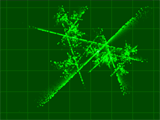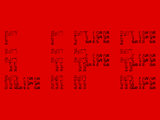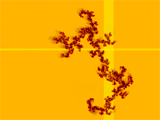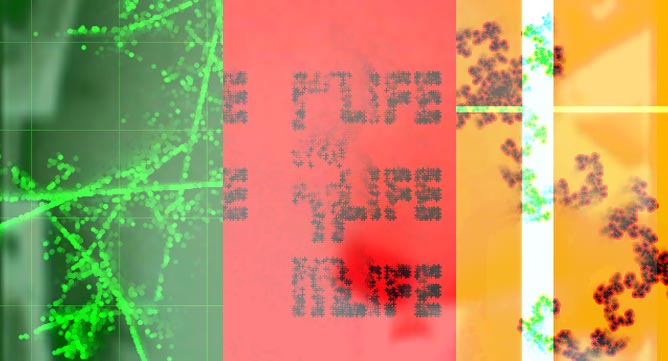MOTION-CONTROLLED›
ITERATED FUNCTION SYSTEM›
VISUALIZATION
This was my final project for MAT 251 - Motion Sensing
Interactive Installation Design, instructed by
George Legrady.
introduction
This project is a motion-controlled visualization of iterated
function systems, a type of self-similar fractal
structure (see below for further details).› Since fractals are usually presented as static imagery
and generated using non-intuitive mathematics (at least to
a non-mathematician), I thought it would be interesting to give the
viewer/user control of the visualization parameters using a simple and
intuitive interface.› In this project, the user's motion in the floor space in front of the
projected visualization is tracked by a camera and used to control the
parameters of the fractal structure in real-time.

Figure 1 - Installation Overview
›
implementation notes
The
project visualization was implemented in Macromedia Director, and used
Smoothware's TrackThemColors extra for camera tracking.
To enable easy configuration and extensibility, I
abstracted an iterated function system as three parent script objects
in Director: IFS, Transform, and
vec (i.e. vector).› An IFS
object contains a collection of Transforms, and each Transform is
defined by three vec objects representing its X axis, Y axis, and center point.›
Each object possesses utility functions that hide much of the
mathematics used.
To allow the user to have influence over multiple transforms in the
IFS, I decided upon a scheme wherein the user's position is directly
mapped to one transform, which the remaining transforms slowly orbit
around.›



Figures 2, 3, 4 - Output of project using different
IFS (click image to enlarge)
›
Thanks go to Andreas Schlegel for his assistance with integrating
camera-tracking into this project.›
›
An iterated function system (IFS) can be defined as an attractor formed by the union of a
finite number of contraction mappings.› This project uses a type
of contraction mapping known as an affine transform, wherein each
transform in the IFS is a scaled, translated,
sheared, and/or rotated image of the entire IFS.› Since this
'self-transformation' occurs an infinite number of times, the IFS
possesses a very complex, self-similar structure.› The amazing
quality of an IFS is that it can be defined
precisely using a very small number of parameters.

Figure 5 - Simulated generation of IFS with three affine
transforms (scale + translation)
To generate an image of the IFS, a random-iteration
algorithm can be used.› Since an IFS is an attractor, if a
point is repetitively transformed by randomly-chosen transforms in the
IFS, the point will gravitate toward only those points in the IFS.
› If the
point is plotted after each random transformation, an image of the IFS'
structure will quickly coalesce.
›
references and links
Donald M. Davis, 'The Nature and Power of Mathematics' - Princeton, 1993
David Peak & Michael Frame, 'Chaos Under Control - The Art and Science of Complexity' - Freeman & Co., 1994
Michael F. Barnsley, 'Fractals Everywhere' - Academic Press, 1993
Macromedia
Smoothware
› |

